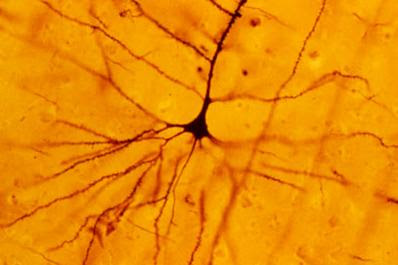The pyramidal neuron is a type of neuron found in areas of the brain including cerebral cortex, the hippocampus, and in the amygdala. Pyramidal neurons are the main excitation units of the prefrontal cortex and the corticospinal tract in human beings. Pyramidal neurons were first discovered and studied by Santiago Ramón y Cajal. Since then, studies on pyramidal neurons have focused on topics ranging from neuroplasticity to cognition.One of the key structural features of the pyramidal neuron is the triangular shaped neuron body, which is called soma; hence the name of the neuron. Other important structural features of the pyramidal cell are a single axon, a large apical dendrite, a basal dendrite, and the presence of dendritic spines. Thousands of pyramidal neurons in sensory, motor, association and executive cortex reveal marked differences in the numbers of putative excitatory inputs received by these cells. Pyramidal nerve cells in prefrontal cortex have, on average, up to 23 times more dendritic spines than those in the primary visual area. It has been proposed that without these specializations in the structure of pyramidal cells, and the circuits they form, human cognitive processing would not have evolved to its present state. Scientific data from both New World and Old World monkeys show varying degrees of complexity in the pyramidal neuron phenotype in their prefrontal cortices, suggesting that cortical circuitry and, thus, cognitive styles are evolving independently in different species.
Pyramidal neurons have been classified into different subclasses based upon their firing responses to 400-1000 millisecond current pulses. These classification are RSad, RSna, and IB neurons. RSad pyramidal neurons, or adapting regular spiking neurons, fire with individual action potentials (APs), which are followed by a hyperpolarizing afterpotential. The afterpotential increases in duration which creates spike frequency adaptation in the neuron. RSna pyramidal neurons, or non-adapting regular spiking neurons, fire a train of action potentials after a pulse. These neurons fail to show any signs of adaptation.































